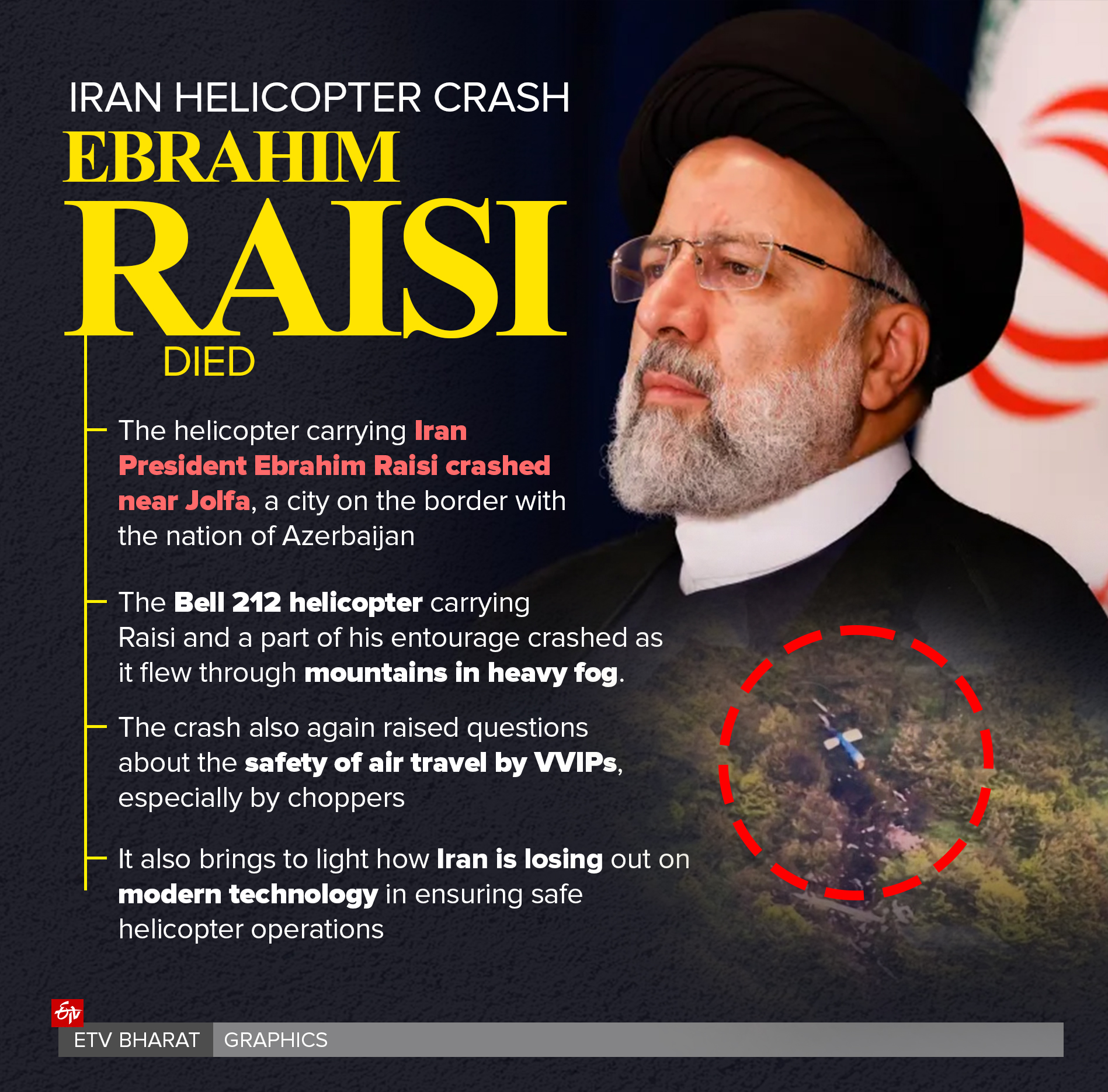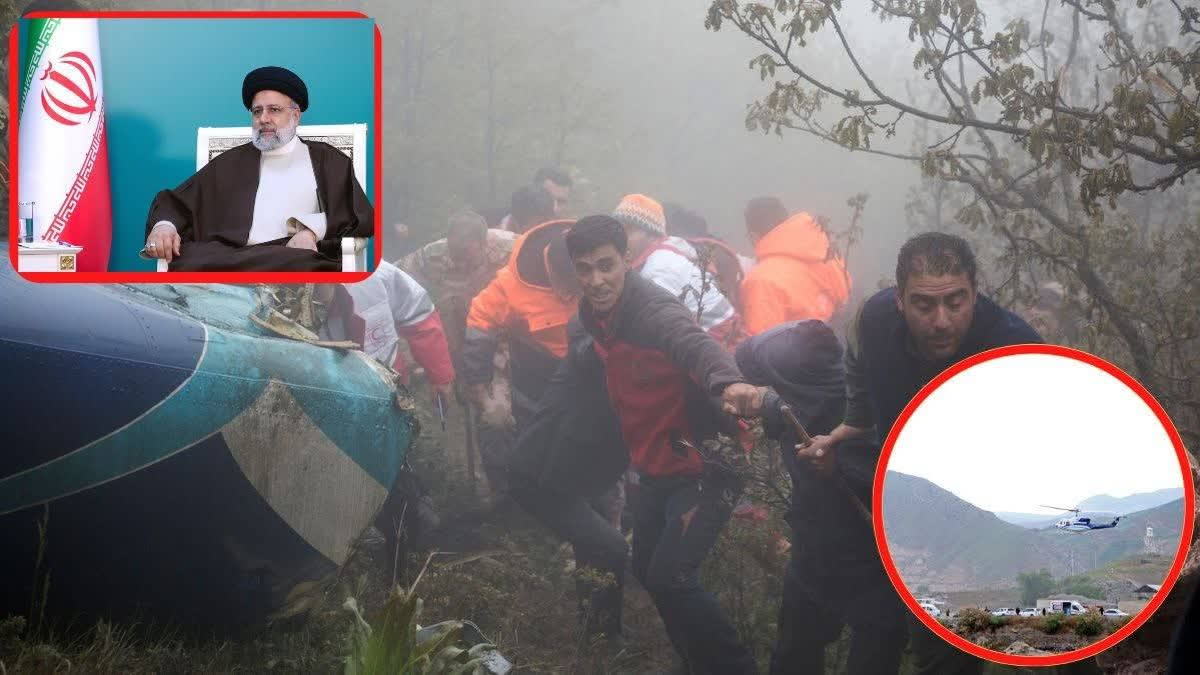New Delhi: The deaths of Iranian President Ebrahim Raisi and Foreign Minister Hossein Amir-Abdollahian on Sunday have again raised questions about the safety of air travel by VVIPs, especially by choppers. The helicopter carrying Raisi and Amir-Abdollahian crashed near Jolfa, a city on the border with the nation of Azerbaijan, some 600 km northwest of Iran’s capital Tehran. According to reports, the Bell 212 helicopter carrying Raisi and a part of his entourage crashed as it flew through mountains in heavy fog.
Helicopters usually fly by visual flight rules (VFR) meaning that the aircraft is intended to operate in visual meteorological conditions (VMC, i.e; nice and clear weather). Clouds, heavy precipitation, low visibility and otherwise adverse weather conditions should be avoided under VFR. Most general aviation flying and flight training occurs in visual meteorological conditions.
However, in today’s technology, helicopters can also fly according to Instrument Flight Rules (IFR). This means that the flight may operate in instrument meteorological conditions (IMC), meaning cloudy or otherwise adverse weather conditions. However, many aircraft may operate under IFR while completing the entirety of the flight in VMC due to the efficiency provided by IFR flying as well as the safety of continuing to avoid bad weather.

“Just because you can fly in the clouds or less than acceptable weather under IFR doesn’t mean you should,” the atpflightschool.com clearly states. A former Indian Air Force (IAF) pilot, who flew MiG 21s and helicopters, speaking to ETV Bharat on the condition of anonymity , said that flying choppers is a different challenge altogether.
“Helicopters don’t have air pressure issues,” the pilot explained. “So they can’t fly too high. They usually fly below clouds. But still, clouds are a big problem.”
The pilot said that transport aircraft and fighter jets fly at far higher heights. Helicopters fly at much lower heights traversing difficult terrain like hills. The operational capabilities are different. The role is different. Helicopters are used for rescue operations during crises like floods, providing humanitarian assistance and evacuations, including operating as air ambulances.
But at the same time, the pilot explained that today’s technology does enable helicopters to use IFR. That is what the US copters used in neutralising Al Qaeda leader Osama Bin Laden in Abbottabad in Pakistan way back in May 2011.
According to the IAF pilot, flying a helicopter with VFR is similar to driving a car. The vision should be clear. What is emerging is that the helicopter Raisi and a part of his delegation were flying in was on VFR mode. Hence, the crash brings into question the helicopter the VVIPs were flying in and the ageing fleet of helicopters in Iran.
The Bell 212 helicopter in which Raisi and partv of his delegation were flying in was introduced in 1968. During the 1970s, when Iran was governed by the pro-American Shah, the Iranian government acquired a significant number of these aircraft. Despite the 1979 Islamic Revolution that toppled the monarchy, Iran continued to utilise many of its American-made aircraft, including advanced fighter jets. However, due to the US sanctions, obtaining spare parts for these aircraft became challenging. Some of the aircraft purchased in the early 1970s, such as the F-4 Phantom and F-14 fighter jets, remain operational even today within the Iranian military.
Now, coming to helicopters. The ageing state of Iran’s helicopter fleet is a result of several interconnected factors, including international sanctions, economic constraints, past procurement practices and difficulties in accessing modern technology and maintenance support.
Sanctions imposed by the US and the European Union have severely restricted Iran’s ability to purchase new helicopters, spare parts and advanced maintenance equipment from Western manufacturers. These sanctions, initially prompted by Iran’s nuclear programme, have limited the country's access to global aviation markets.
Iran’s economic challenges, such as high inflation, currency devaluation and reduced oil revenue due to sanctions and price fluctuations have constrained the budget available for defence and aviation sectors. Within the limited budget, resources are often prioritised for critical areas like healthcare and infrastructure, leaving the helicopter fleet underfunded for modernisation and expansion.
Many of Iran’s helicopters were acquired during the 1960s, 1970s and 1980s from the US and European countries before the 1979 Iranian Revolution strained diplomatic relations and military sales. Following the revolution and subsequent sanctions, Iran’s ability to diversify its sources for new helicopters was severely limited, leading to an over-reliance on ageing Western-made assets.
Efforts to develop domestic capabilities in aircraft and helicopter manufacturing and maintenance have been hampered by technological gaps and lack of access to advanced materials and technologies. Sanctions and diplomatic isolation have also restricted the flow of technical knowledge and expertise from more advanced aviation industries, hindering skill development and effective maintenance.
Environmental factors like harsh operating conditions and heavy utilisation for various purposes have accelerated the ageing process of Iran’s helicopter fleet. While Iran has attempted to modernise its fleet through domestic initiatives, overhauls and strategic partnerships with countries like Russia and China, the path to a fully modernised and reliable helicopter fleet remains challenging due to the combined impact of these factors.



